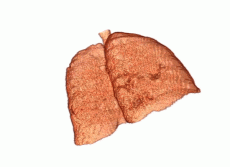Accelerating COVID-19 Triage and Screening
September 17, 2020

Ushizima and her collaborators are developing a method to narrow the search area on a CT scan or chest X-ray just to the lungs, then detect the lung lesions. (Image courtesy of Daniela Ushizima, Berkeley Lab)

Dani Ushizima leads an Image Processing/Machine Vision team at Berkeley Lab and the Center for Recognition and Inspection of Cells at BIDS where her research focuses on imaging cancer cells for early-stage disease diagnosis.
Investigators: Daniela Ushizima
Affiliation: Berkeley Lab
Berkeley Lab researcher Dani Ushizima and her team are working to amplify COVID-19 testing and surveillance by exploring a diverse set of data, including patient vitals, with suspected COVID-19 infection. The goal of the project is to amplify COVID-19 testing and surveillance by exploring multimodal data, including patients' vitals, when available, with suspected COVID-19 infection. Team is evaluating individually and combined information from lung scans, particularly CT and CXR using convolutional neural networks. Alternative methods to screen, stage and rank cases of COVID-19 are a key issue as long as vaccines are not available, which is one of the motivations for focussing on lung scans characterization (with UCSF, VA and Thomas Jefferson Univ.). Another motivation is to create mechanisms for rapid image analysis and learning in situations that require rapid emergency preparedness.
One of the several challenges in developing vaccines is to unravel how infection by the SARS-CoV-2 virus alters infected cells, and to identify viral and cellular targets perturbed by infection that are suitable for antiviral therapy. In this research area, a promising imaging technology for studying COVID-19 infected cells is soft X-ray tomography (SXT) – here LBNL is at the forefront of imaging the mechanisms by which the SARS-CoV-2 human cells, and requires immediate support for complex analysis of structure and organization of the human cells modified by the virus, which have been imaged using SXT – this is also a focus of this multimodal imaging LDRD that aims to accelerate COVID-19 testing and screening.
About Computing Sciences at Berkeley Lab
High performance computing plays a critical role in scientific discovery. Researchers increasingly rely on advances in computer science, mathematics, computational science, data science, and large-scale computing and networking to increase our understanding of ourselves, our planet, and our universe. Berkeley Lab’s Computing Sciences Area researches, develops, and deploys new foundations, tools, and technologies to meet these needs and to advance research across a broad range of scientific disciplines.







 Instagram
Instagram YouTube
YouTube